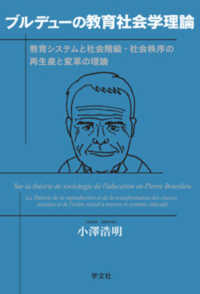- ホーム
- > 洋書
- > 英文書
- > Science / Mathematics
Full Description
Sorghum and Millets: Chemistry, Technology, and Nutritional Attributes, Third Edition is the leading resource for state-of-art knowledge on grain science and utilization surrounding sorghum and millets. The book covers important scientific knowledge, including basic science—genetics, chemistry, and biochemistry—food chemistry, nutritional quality and health-promoting attributes, agronomy, and food and feed processing technologies. Other sections delve into structure, chemistry, biochemistry, grain components, and the technologies used for food processing. Additionally, it provides holistic and complete information about all technologies in the sorghum and millets food value chain, from genomics-based breeding to grain- and product quality assurance.
Sorghum and the millets are the 5th and 6th most important cereal grains in terms of production and are cultivated across the world. They have a very wide range of end-uses as traditional staple foods and beverages, modern processed foods, and with respect to sorghum, industrial applications, including biofuels, and as an animal and aquaculture feedstuff.
Contents
1. Current and future state of sorghum in the 21st Century
2. Current and future state of millets in the 21st Century
3. Taxonomy, history, distribution, production and utilization.
4. Breeding and agronomy
5. Application of plant breeding and genomics for improved sorghum and millet grain nutritional quality
6. Post-harvest technologies
7. Grain structure and grain chemical composition
8. Starch synthesis, chemistry and functional properties
9. Protein synthesis, chemistry and functional properties
10. Impact of processing technologies on nutrients and nutrient bioavailability
11. Intervention trials and epidemiological studies
12. Phytochemical-related health-promoting attributes
13. Traditional food and beverage products and their technologies
14. Modern convenient food and beverage products and their technologies
15. Gluten-free dough-based foods and technologies
16. Feed grains for animal production, companion animals and aquaculture
17. Industrial and nonfood applications
18. Quality management systems




